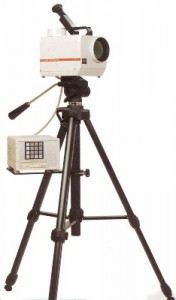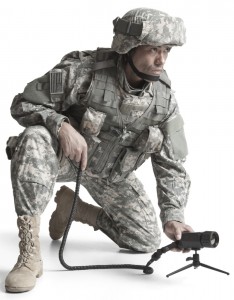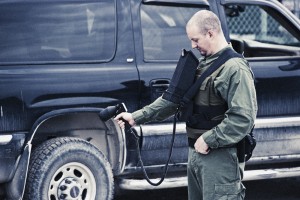Dark Busters: Revealing Hidden Threats with Uncooled IR Detectors
Ken Smart puts his imaging systems into some of the toughest environments on the planet. Here he reflects on the past, present and future of lightweight, uncooled infrared cameras and their game-changing potential, even in applications outside of the world’s most dangerous hot spots.
For all that human vision enables us to do in the world, it falls short in one important and common environment: without help, we are not well equipped to detect objects or navigate when there isn’t much light.
Some non-sighted persons can navigate through echolocation, also known as acoustic wayfinding. By making clicking noises with their mouths, for example, they can experience their surroundings with astonishing accuracy. Scientific studies show that as they “sound out” the world, they use many of the same parts of the brain that a sighted person would, their visual cortex lighting up like a disco ball.
Yet that’s not a problem for some blind or visually impaired people. In fact, they can often safely explore almost any environment. So there are different ways of “seeing”—some of which might challenge our understanding of the concept, perhaps leaving it reduced to nothing more than a social construct.
Indeed, vision can be regarded as an act of the imagination. And while we might be challenged to perceive what is obscured by darkness or distance, or by thick smoke, fog or physical barriers, we continue to imagine new and better ways of seeing the unseen.
 The Jenoptik Varioscan with its external processing unit. When this was announced (around 1994) it was quite an advance over previous products. Note the cap for the liquid nitrogen reservoir on the top.
The Jenoptik Varioscan with its external processing unit. When this was announced (around 1994) it was quite an advance over previous products. Note the cap for the liquid nitrogen reservoir on the top.
IR from Shoe Box to Film Box
Over the last few decades, more people are focusing on the benefits and advantages of thermal imaging as a method of seeing the non-visible. Steady improvements in sensitivity, array size and production methods have made uncooled long-wavelength infrared (LWIR) detectors more practical and affordable. Small, wafer-level packaging means that the IR sensor can also be small, of lower weight, consume less power and cost tens of dollars instead of hundreds or thousands of dollars.
“Microbolometers are very good now, and quite usable in a wide variety of applications,” says Ken Smart, founder and president of Toronto-based Eomax Corp. “They are ideal in the context of what we make: high-mobility, rapid-deployment cameras and peripherals required for sophisticated ISR systems—intelligence, surveillance and reconnaissance.”
A lot has changed since Smart was first exposed to thermal imaging in the early 1990s.
“We were out there in the field flogging cameras that required liquid nitrogen cooling from a reservoir or, alternatively, a large and power-hungry cooler, just to keep the noise down to get a decent image,” he recalls. “They were good at the time, but oh…those cameras were large.”
They were also cumbersome to operate and required body braces with a tripod connector that would allow a person to work hands-free with the camera perched in front.
In 2004, Smart launched Eomax so he could continue developing his modular, multi-mission Wolf Pack tactical vision system—named after a fascination with the social structure of wolves and their different roles and responsibilities within a group. Since then, his company has sustained an aggressive pace of innovation for the system’s imaging components.
Ken Smart is the founder and president of Toronto-based Eomax Corp, which designs and manufactures remote viewing technology for applications in defence, search and rescue, and industrial markets.
“When I look at the first versions of thermal cameras we introduced around 2006—the C7 series—they were fantastically small compared with what had come before,” Smart explains. “We graduated from the C7to the CT2 series, and in the context of SWAP—“Size, Weight and Power,” which is what the military uses as evaluation criteria—they, too, were a vast improvement. They were literally half the size and weight. Now we have the CT3. Although they look identical to the CT2 they have 17-micron sensors, which delivers four times the pixel resolution.”

Wolf Pack systems are designed for tough applications.
He adds: “Our cameras have become progressively better in terms of their thermal sensitivity and spatial resolution. At the same time, we’ve evolved from a unit that was the size of a large shoe box, consumed vast amounts of power and required liquid nitrogen cooling to something that’s the size of a 35mm film box—a comparison that I suppose comes from my background with a degree in photography.”
Smart laughs. “I’m assuming, of course, that people will remember what a 35mm film box looks like, right?”
It’s Tough Out There in the Real World
Another aspect of smaller, lighter and less power-hungry thermal cameras powered by microbolometer technology appeals to Smart’s personal and vested interest in ergonomics.
“In the military and security markets, there’s this added layer associated with working in high-risk environments, and so the emphasis on workflow- and technology-effectiveness is much higher than it would be in industrial settings.”
While that’s said from the comfort of a spacious loft studio office in a converted chewing gum factory far from any battle zone (discounting any typical big-city issues related to parking), it reflects an understanding of what really happens in some very dangerous parts of the world—places in which Wolf Pack gear is used every day.
Infrared imaging can reveal things invisible to visual vehicle searches.
“You have a much-enhanced detection capability with thermal over near-infrared night vision,” Smart explains. “If you’re part of a tactical team making a building entry, and you’re doing room clearing and you’re using our cameras with perhaps an extensible pole to be able to look into rooms from a position of cover, you have an advantage. With a near-infrared night vision camera, you would have to look at all the objects in the visible field to see whether anyone is there. That means time, and time can be deadly. With a thermal camera, because the human body has a significantly different temperature than a surrounding room, a person stands out like a light bulb. Even if someone is crouched behind a piece of furniture, if any part of his or her anatomy is sticking out, you will see it immediately. That’s significant in a real-world scenario.”
For all that, Smart acknowledges a downside to thermal imaging. “You cannot do positive ID. You could if you were using near-infrared night vision, but you can’t with thermal. But there are lots of applications where positive identification is not part of the mission set.”
A Unified, Multi-Spectral Future
Those mission sets cover a lot of ground. From Afghanistan to the Arctic, Wolf Pack’s field-configurable system has proven its value in tactical operations, contraband interdiction, search and rescue, surveillance and more.
Meanwhile, uncooled microbolometer sensors are finding an increasing number of uses in other fields, such as industry, medicine and agriculture, in addition to opening new possibilities for a range of consumer applications.
Looking ahead, thermal imaging can also complement other vision systems.
“Multi-spectral imaging is kind of this catch-all phrase for combining different types of cameras to deliver the benefits of each in a single package,” says Smart. “An advanced fusion engine will dynamically allocate pixels from a short-wave infrared night-vision camera alongside a thermal camera and overlay them so that you get the best possible image in any situation.”
He goes even further.
“I think the ultimate is going to be when we have fairly high-resolution forward-looking infrared cameras combined with night vision and even low-light visible-spectrum color images. That ends up as somewhat larger, but the technology is getting to the point where it can provide a degree of performance to have sufficient value to those who can live with the size for operational reasons.”
What else might we see? The answer to that question depends on one’s imagination—or vision.





 Seeing the Unseen with Microbolometer Technology
Seeing the Unseen with Microbolometer Technology  When the Invisible Becomes Visible
When the Invisible Becomes Visible 